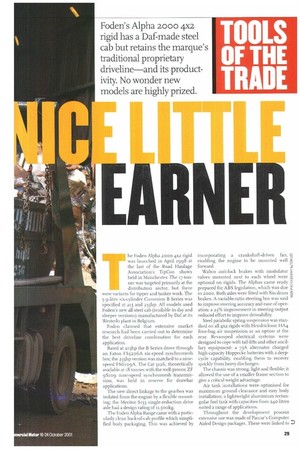EA R NE R T he Foden Alpha 2000 4x.2 rigid was launched in
Page 29

If you've noticed an error in this article please click here to report it so we can fix it.
April 1998 at the last of the Road Haulage Association's TipCon shows held in Manchester. The -17-tonner was targeted primarily at the distribution sector, but there were variants for tipper and tanker work. The 5.9-litre six-cylinder Cummins B Series was specified at 215 and 235hp. All models used Foden's new all-steel cab (available in day and sleeper versions) manufactured by Daf at its Westerlo plant in Belgium.
Foden claimed that extensive market research had been carried out to determine the best driveline combination for each application.
Rated at 2r5hp the B Series drove through an Eaton FS52o6A six-speed synchromesh box; the 235hp version was matched to a ninespeed FS61o9A. The Cat 3126, theoretically available at 18 tonnes with the well-proven ZF 951o9 nine-speed synchromesh transmission, was held in reserve for drawbar applications.
The new direct linkage to the gearbox was isolated from the engine by a flexible mounting; the Mentor S153 single-reduction drive axle had a design rating of I1,500kg.
The Foden Alpha Range came with a particularly clean back-of-cab profile which simplified body packaging. This was achieved by
incorporating a crankshaft-driven fan, enabling the engine to be mounted well 3 forward.
Wabco anti-lock brakes with modulator valves mounted next to each wheel were g optional on rigids, The Alphas came ready 2
prepared for ABS legislation, which was due E in 2000. Both axles were fitted with Sin drum 1 brakes. A variable-ratio steering box was said to improve steering accuracy and ease of operation: a 23% improvement in steering output reduced effort to improve driveability.
Steel parabolic spring suspension was standard on all 4x2 rigids with Hendrickson HA4 four-bag air suspension as an option at the rear. Revamped electrical systems were designed to cope with tail-lifts and other ancillary equipment; a 75A alternator charged high-capacity Hoppecke batteries with a deep. cycle capability, enabling them to recover quickly from heavy discharges.
The chassis was strong, light and flexible; it allowed the use of a smaller frame section to give a critical weight advantage.
Air tank installations were optimised for maximum ground clearance and easy body installation; a lightweight aluminium rectangular fuel tank with capacities from 240 litres suited a range of applications.
Throughout the development process extensive use was made of Paccar's Computer Aided Design packages. These were linked to D












































































































































